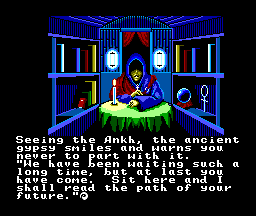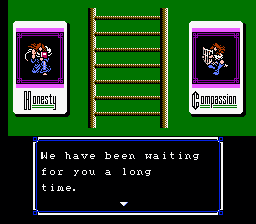Introduction
In Ultima 4: Quest of the Avatar you control a hero and a team of eight adventurers in a quest across the fantasy world of Britannia. During the game, the party members can progressively acquire several weapons and armors, but also many other items and a wide array of spells.
Ultima 4 is a role-playing video game. Specifically, it belongs to the sub-genre of American-style RPVGs.
Three aspects that can define the genre of RPGs are listed here, and they apply to Ultima 4 as well:
- Text is an essential part of the game, and the characters have to talk and interact with non-evil characters to proceed in the adventure;
- There are permanent upgrades, in the form of enhancements of the various attributes of the characters (attack, strength, magic etc.);
- There is freedom of exploration, all the areas are connected by an "overworld", and areas that have been previously cleared can usually be re-visited; in other words, the game is non-linear.
Japanese-style RPVG focus more on the plot, while American-style RPVG like Ultima 4 focus more on exploration and "body-building" of the characters. Nevertheless, all three aspects are present in every RPG.
Game versions
Ultima 4 was ported on different systems and consolles.
| Year | Port | Notes |
|---|---|---|
| 1985 | Apple II | The original port. |
| 1985 | Atari 8-bit | Essentially identical to the original port. |
| 1985 | C64 | Some improvements to graphics and RAM requirements, but very long loading times. |
| 1985 | MS-DOS | Some improvements to graphics, but no music at all. |
| 1987 | MSX & PC-8801 | Japanese only; almost identical to the original port, with improved graphics. |
| 1987 | PC-9801 | Japanese only; almost identical to the original port, with further improved graphics. |
| 1988 | Amiga & Atari ST | Great improvements to graphics and sound, especially in dungeons; mouse is featured. |
| 1989 | NES | REMAKE. Very different graphics and music; reduced dialogues; controls modified for joypad. The Japanese version features many more inhabitants in the towns, with longer dialogue. |
| 1990 | Sega MS | Further improvements to graphics; controls modified for joypad; overhead dungeons instead of first person; released in Japan, Europe and South America, but not in North America. |
| 1992 | FM Towns | Japanese only; essentially identical to the MS-DOS port, with added music. |
| Original version | (1985) Apple II |
|---|---|
| Most popular port | (1985) MS-DOS |
| Most advanced ports | (1985) Amiga (1990) Sega Master System |
| Remake | (1989) NES |
| Fan-made upgrade | (2001) Upgrade patch for MS-DOS port |
Comparison screenshots
-
(1985) MS-DOS
-
(1988) Amiga
-
(1990) Master System
-
(1989) NES remake
Similar games
- Ultima 5 and Ultima 6, that together with Ultima 4 constitute the Age of Enlightment trilogy;
- Ultima 3, Ultima 7 and Ultima 7 Part 2, where the player still controls a team of heroes.



